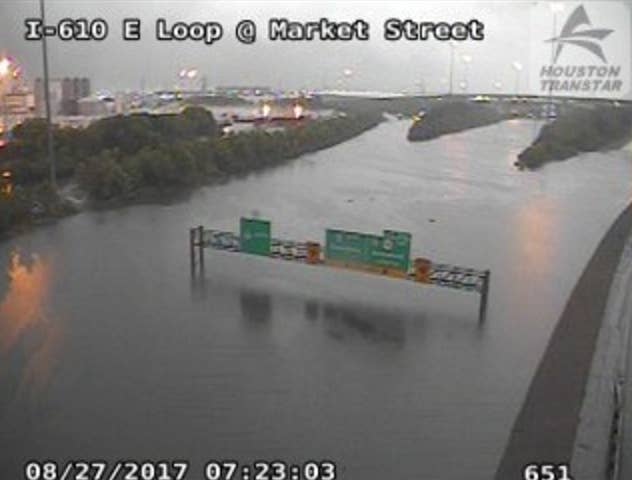The remains of Hurricane Harvey have stalled out over Texas's Gold Coast and Houston, Galveston, and Bay City have already been inundated with two feet of rain...with several more feet of rain on the way today and tomorrow.

Catastrophic flooding in the Houston area is expected to worsen and could "become historic," the National Weather Service has warned.
Flash flooding is expected to continue in other areas of southeast Texas as well. Hourly rain totals in the region have reached 3 inches with local amounts of up to 7 inches expected. About 35 inches of rain is expected to fall in the area on Sunday.
Over the past 24 hours, Houston/Galveston has received 24.10 inches of measured rain. The rainfall has made August the wettest month on record for Houston.
I don't know how many folks we have out there in the Houston area, but dear God I hope you're not anywhere near there and that you're safe. "Catastrophic flooding" doesn't begin to describe this and Harvey is expected to stick around Houston until at least Tuesday.
This is one of the worst disasters in US history unfolding right now, and it may be months before we know the full extent of damage. The real problem is that the heaviest rains aren't just falling on the coat, but inland towards Austin and College Station, meaning even more flooding as the waters race downstream towards Houston.
By the way, author, historian, and Notre Dame professor Roy Scranton warned that Houston was going to be America's next major flooding disaster back last October:
Isaiah whirls through the sky, gathering strength from the Gulf of Mexico’s warm waters. Beach towns are evacuated. Citizens and companies in Texas’ petro-industrial enclaves from Bayou Vista to Morgan’s Point are warned: Prepare for the worst.
The huge cyclone gathers strength as it nears the barrier islands off the coast, intensifying to Category 4. Hours before landfall, 150 mile-per-hour winds begin pushing water over the Galveston Seawall, and by the time the eye finally hits, Galveston has been flattened by a 20-foot wave.
Isaiah’s monstrous arm reaches across the bay toward Houston, some 50 miles inland, adding water to water, and when it smashes into the Exxon Mobil Baytown refinery, the storm surge is over 25 feet high. It crashes through refineries, chemical storage facilities, wharves and production plants all along the Houston Ship Channel, cleaving pipelines from their moorings, lifting and breaking storage tanks.
As Isaiah passes inland, the iridescent, gray-brown flood rises, carrying jet fuel, sour crude and natural gas liquids into strip malls, parks, schools and offices. More than 200 petrochemical storage tanks have been wrecked, more than 100 million gallons of petroleum and chemicals spilled. Damages for the region are estimated at more than $100 billion. More than 3,500 are dead. It is one of the worst disasters in United States history: worse than the 1906 San Francisco earthquake, worse than Hurricane Katrina, worse than the terrorist attacks of Sept. 11.
The good news is that Isaiah hasn’t happened. It’s an imaginary calamity based on research and models. The bad news is that it’s only a matter of time before it does.
Any 50-mile stretch of the Texas coast can expect a hurricane once every six years on average, according to the National Weather Service. Only a few American cities are more vulnerable to hurricanes than Houston and Galveston, and not one of those is as crucial to the economy.
When the next big storm hits there, the effects will ripple across the globe. The Gulf Coast is home to roughly 30 percent of the United States’s proven oil reserves; The Gulf Coast and Texas hold 35 percent of its natural gas reserves. The refineries and plants encircling Galveston Bay are responsible for roughly 25 percent of the United States’s petroleum refining, more than 44 percent of its ethylene production, 40 percent of its specialty chemical feed stock and more than half of its jet fuel.
Houston is the second busiest port in the United States in terms of pure tonnage and one of the most important shipping points in the country for natural gas liquids. A hurricane like Isaiah would shut all that down.
There’s more: Future hurricanes will actually be worse than Isaiah. The models Isaiah is based on, developed by Rice University’s Severe Storm Prediction, Education and Evacuation From Disaster (Sspeed) Center, don’t account for climate change. According to Jim Blackburn, Sspeed’s co-director, other models have shown much more alarming surges. “The City of Houston and FEMA did a climate change future,” he told me, “and the surge in that scenario was 34 feet. Hurricanes are going to get bigger. No question. They are fueled by the heat of the ocean, and the ocean’s warming. Our models are nowhere close.”
Isaiah just happened, folks. This is going to take years to fix. People are still dealing with the aftereffects of Katrina twelve years later and this storm will be far worse for flooding and damage. The $100 billion price tag from that storm will pale in comparison I think. That's how awful this storm is.
I can't stress how bad this is, guys. Stay safe, Texas.




No comments:
Post a Comment